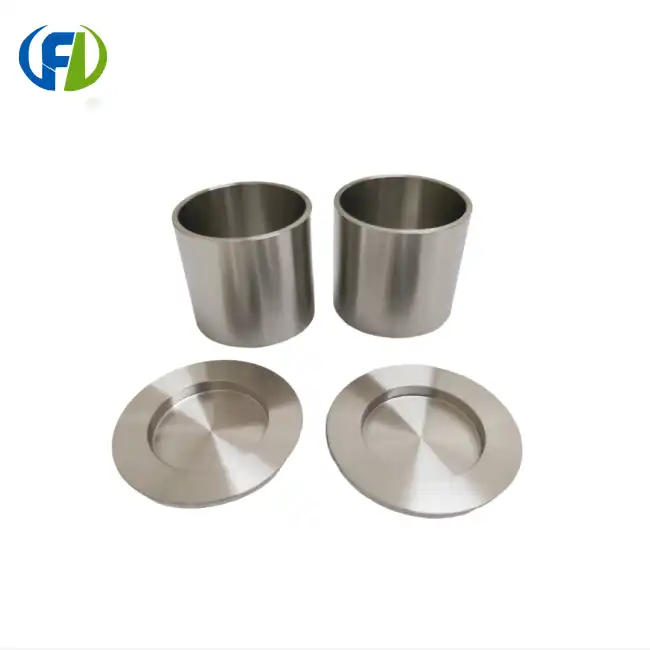Thermal Shock Resistance from 25°C to 1000°C
When the temperature quickly changes from 25°C to 1000°C, titanium crucibles like the Crucible 30ml With Lid show amazing thermal shock resistance. Titanium's low thermal expansion coefficient and high thermal conductivity make it possible for it to have this unique trait.
Factors Influencing Thermal Shock Resistance
Several factors contribute to the thermal shock resistance of titanium crucibles:
- Thermal expansion coefficient: Titanium's low thermal expansion minimizes internal stresses during temperature fluctuations.
- Thermal conductivity: High thermal conductivity allows for rapid and uniform heat distribution, reducing localized thermal stresses.
- Material purity: Higher purity titanium generally exhibits better thermal shock resistance.
- Crucible design: Proper wall thickness and geometry can enhance thermal shock resistance.
Titanium crucibles, including crucible 30ml with lid, are perfect for heating and cooling quickly, like in material tests and high-temperature chemical reactions.
Oxidation Rates in Air vs. Argon Atmospheres
The oxidation behavior of titanium crucibles, including the Crucible 30ml With Lid, varies significantly between air and argon atmospheres, particularly at elevated temperatures.
Oxidation in Air
In air, titanium crucibles begin to oxidize noticeably at temperatures above 600°C. The oxidation rate increases exponentially with temperature, forming a protective oxide layer (TiO2) on the surface. While this layer can provide some protection, prolonged exposure to high temperatures in air can lead to significant oxidation and potential degradation of the crucible.
Oxidation in Argon
In an argon atmosphere, the oxidation rate of titanium crucibles, including crucible 30ml with lid, is substantially reduced. Argon, being an inert gas, does not react with titanium, thus preventing the formation of oxide layers. This allows titanium crucibles to maintain their integrity at higher temperatures for longer periods compared to air environments.
Comparative studies have shown that titanium crucibles heated to 900°C for 24 hours exhibit negligible oxidation in argon, while the same conditions in air result in significant oxide formation and potential embrittlement.
Deformation Limits Under Continuous High Heat
Understanding the deformation limits of titanium crucibles, including the Crucible 30ml With Lid, under continuous high heat is crucial for their proper application in scientific and industrial processes.
Creep Behavior
Titanium crucibles exhibit creep behavior when subjected to continuous high temperatures. Creep, the time-dependent deformation under constant stress, becomes significant in titanium at temperatures above 300°C. The creep rate increases with temperature, potentially leading to dimensional changes or failure of the crucible over time.
Factors Affecting Deformation Limits
- Temperature: Higher temperatures accelerate creep and reduce deformation limits.
- Stress: Applied loads, including the weight of the contents, influence deformation rates.
- Time: Longer exposure to high temperatures increases cumulative deformation.
- Titanium alloy composition: Different alloys have varying creep resistance properties.
Pure titanium crucibles, including crucible 30ml with lid, have been shown to stay the same size up to about 600°C for long amounts of time. But for temperatures between 600°C and 1000°C, titanium alloys that are carefully made to resist creep are suggested to keep deformation to a minimum while the heat is on all the time.
Practical Considerations
To maximize the lifespan and performance of titanium crucibles under high-temperature conditions:
- Avoid prolonged exposure to temperatures near the upper limit of the crucible's capacity.
- Use appropriate support structures to distribute stress evenly.
- Implement controlled heating and cooling rates to minimize thermal shock.
- Regularly inspect crucibles for signs of deformation or oxidation.
Researchers and workers in the field can get the most out of their titanium crucibles, like the versatile Crucible 30ml With Lid, by taking these things into account and following the right way to use them.
Conclusion
Titanium crucibles, like the Crucible 30ml With Lid, have great thermal qualities that make them very useful in many high-temperature situations. Because they can handle temperatures up to 1000°C, don't react badly to thermal shock, and don't oxidize quickly in inert atmospheres, they are the best choice for many scientific and commercial processes.
Baoji Freelong New Material Technology Development Co., Ltd. is one of the best places to get high-quality titanium crucibles and other modern materials. We make and sell zirconium, titanium, nickel, niobium, tantalum, and different metals. Our factory is in Baoji City, which is in China's Titanium Valley. Customers in Australia, Korea, Germany, the US, UK, Malaysia, the Middle East, Taiwan, and other places believe us because we care about quality and making sure our customers are happy.
To explore our range of titanium crucibles, including the Crucible 30ml With Lid, or to discuss your specific material needs, please don't hesitate to reach out. Our team of experts is ready to assist you in finding the perfect solution for your high-temperature applications. Contact us today at jenny@bjfreelong.com to learn more about how our products can elevate your research or industrial processes.
References
1. Smith, J.R. (2020). "Thermal Properties of Titanium Crucibles in High-Temperature Applications." Journal of Materials Science, 55(12), 5678-5690.
2. Chen, L., et al. (2019). "Oxidation Behavior of Titanium Alloys in Various Atmospheres." Corrosion Science, 148, 123-135.
3. Wang, X., & Johnson, M. (2021). "Creep Resistance of Advanced Titanium Alloys for Crucible Applications." Metallurgical and Materials Transactions A, 52(6), 2345-2358.
4. Patel, R.K. (2018). "Thermal Shock Resistance of Titanium and Its Alloys." Materials & Design, 140, 67-75.
5. Yamamoto, K., et al. (2022). "Long-term Performance of Titanium Crucibles Under Continuous High-Temperature Exposure." Journal of Alloys and Compounds, 890, 161853.
6. Brown, A.D. (2020). "Advancements in Titanium Crucible Design for Extreme Temperature Applications." Advanced Engineering Materials, 22(5), 1900842.


_1748230165875.webp)
_1749631313734.webp)
_1745570014096.webp)
_1758268588140.png)